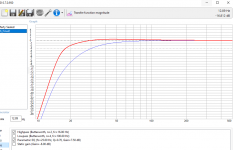While you're doing that, run it again with some pink noise at high excursion. Very unlikely to hurt it with that amp.
FWIW, if you lowpass (not a typo) the pink noise at 20Hz, you get a useful signal for breaking in subwoofers.
To the OP, if you're considering used amps, you should be able to find a Crown MA5002VZ (or 5000) for that sort of money. Make sure the fans are silent on start-up - they should only spin up when the amp starts getting warm.
Just a thought: how long are the cables from amplifier to subwoofer?
Chris
You could give it a try in an open baffle arrangement? Since the driver has plenty excursion capability, and you have dsp processing and plenty of amplifier power available.....
long decay, to me is a room issue or a box design issue (but your using a sealed box which can't have these issues - but should be well stuffed to avoid higher frequency resonances). Your room also sounds very solid? (IE low loss) which will cause modal issues to be more severe. Decay is easily measurable using the waterfall plot on REW or CSD to find the problem frequencies. EQ is not a total fix for modal issues as when you look at a long windowed freq sweep your integrating over a long period of time (represents steady state response). However your ears/body and the music are able to sense the transient behavior. For example if you have a big high Q spike in response you EQ down to flat then it will take a long time for energy to build up at that frequency and thus bass around that frequency will sound too weak.
Perhaps what you should do is sell the big 21" and get multiple smaller subs if your SPL requirements are modest. Some discussion here:
DIY sub fixed to the wall&floor and firing with an angle? - Bass Projects - Data-Bass Forums
but tl:dr 4 subs sounds way better than 1 in a domestic environment as it reduces the modal behavior of the room, achieving similar results to extensive bass traps while occupying less space.
Another thing to check is what your acoustic crossover frequency is between your mains and sub. It can be set to 80Hz electrically but if the sub is +12dB hot relative to the mains then the effective crossover frequency will be much higher.
Perhaps what you should do is sell the big 21" and get multiple smaller subs if your SPL requirements are modest. Some discussion here:
DIY sub fixed to the wall&floor and firing with an angle? - Bass Projects - Data-Bass Forums
but tl:dr 4 subs sounds way better than 1 in a domestic environment as it reduces the modal behavior of the room, achieving similar results to extensive bass traps while occupying less space.
Another thing to check is what your acoustic crossover frequency is between your mains and sub. It can be set to 80Hz electrically but if the sub is +12dB hot relative to the mains then the effective crossover frequency will be much higher.
Ernie, I will try adding some sound deadening. I have a 2'x4' 5" thick piece of wool sound deadening I can throw in there.
Bob, I was breaking in the sub before in low frequencies freeair and it pressurized the room and house so much it was not fun to listen to. Wife complained. 🙂 It might work free air/open baffle, but there would be no kick.
Chris, I use balanced xlr from my avr about 30' to the amp and then nice 10 gauge audio grade belden to the sub, about 7'. If I get a amp requiring a 20a circuit, I will have to extend the speaker wire a lot to get the amp closer to my available 20A circuit, by about 30' with that 10 gauge wire. I am not sure if that is ok at this wattage.
Kipman, the box is actually ported and tuned to 17hz - its a pretty long port, maybe 3.5' long and 3" tall and 22" wide. The room is a basement - about 45'x30' with concrete 9' walls, wall insulation all around and on the ceiling, and lots of junk all around to break up sound waves behind me (half of the space is normal basement, and half is my movie room, but the wall between the two areas are just studs, so essentially open). The walls near my speakers are lined with wool, and the carpet is thick with a thick pad under it. Its eerily dead down there, ala anechoic chamber. People who know nothing about audio have commented it sounds "weird" in my room.
I'll have to look into the waterfall plot/decay thing . I dont know how to do that but it would be very interesting for me to look at. It will show me how accurate the driver is?
I already have 4 other subs. Two are 10" and two are 12", all dynaudio. These are very high quality musical subs and until I was in such a large basement, they were more than adequate. They do actually pretty well in my room, but are not as punchy as I like/remember.
Some of the issues I'm seeing/feeling may be a result of no longer being on a wood floor that would transmit some of that LF energy to me via the seat. After years of wondering, on a whim, I went and bought some bass shakers and I LOVE the effect of those. After I tune the subs, I turn them on a little and it adds a nice effect to the movie experience. I always thought these things were hype, especially as a snooty audiophile, but wow, for $50 there is no better upgrade you can do to your HT! Really, if you have a cheap amp lying around to power it and wanna try something fun, go get one. I bought the AURA pro.
More recently, I've been playing with cuttoffs of my four HT subs in conjunction with my 21" and found an interesting balance where I cross the 10's [all rough numbers here, still playing] 95-50hz, 12"s 80-35hz and the 21" 50-17hz. I get some surprising punch from the 10's some nice blend with 12's across the workhorse range, and the 21" plays all the really low stuff, which ATM is all its good at. What I'm trying to do is maybe remove either the 10's or 12's from the equation and simplify and get the 21" to perform higher up the frequency range. Because of its size, if I can get it to play nice in the 60-100hz range without nasties, I will get a lot more punch out of it. BTW, I have modified the heights of my subs and that made a HUGE difference - did this long before the 21" was in the room. I have my 10's roughly ear level, and my 12's at different heights, closer to the ground. The 21" is on its side at the moment, which is likely not ideal due to the port location not being on the floor, but a lot of people do it. I am going to try it vertical with the port at the bottom pretty soon. I hear this essentially extends the port and can have a good impact.
One of the reasons I want to simplify is that tuning one or even a pair of woofers in minidsp/REW is really pretty easy, even fun I might say. But, add in two other types of subs and you get all sorts of wave cancellations and dips that gets very hard to tune out. All of my curves were flat and then I added them all together and get a really nasty dip (around 50-60hz if memory serves), and maybe another place or two.
Kipman, when I use my AVR to cross out the low pass, its pretty good (most of my speakers are at 80hz). I did end up playing with the 21's low pass because it was a little hot up high, and couldnt do it. This is likely due to the boosting I did to get the curve flat. Wit that said, I did run the sub with no EQ'ing (other than the safety high pass 24db at 16hz), and it didnt make a difference to the SQ of the sub.
Bob, I was breaking in the sub before in low frequencies freeair and it pressurized the room and house so much it was not fun to listen to. Wife complained. 🙂 It might work free air/open baffle, but there would be no kick.
Chris, I use balanced xlr from my avr about 30' to the amp and then nice 10 gauge audio grade belden to the sub, about 7'. If I get a amp requiring a 20a circuit, I will have to extend the speaker wire a lot to get the amp closer to my available 20A circuit, by about 30' with that 10 gauge wire. I am not sure if that is ok at this wattage.
Kipman, the box is actually ported and tuned to 17hz - its a pretty long port, maybe 3.5' long and 3" tall and 22" wide. The room is a basement - about 45'x30' with concrete 9' walls, wall insulation all around and on the ceiling, and lots of junk all around to break up sound waves behind me (half of the space is normal basement, and half is my movie room, but the wall between the two areas are just studs, so essentially open). The walls near my speakers are lined with wool, and the carpet is thick with a thick pad under it. Its eerily dead down there, ala anechoic chamber. People who know nothing about audio have commented it sounds "weird" in my room.
I'll have to look into the waterfall plot/decay thing . I dont know how to do that but it would be very interesting for me to look at. It will show me how accurate the driver is?
I already have 4 other subs. Two are 10" and two are 12", all dynaudio. These are very high quality musical subs and until I was in such a large basement, they were more than adequate. They do actually pretty well in my room, but are not as punchy as I like/remember.
Some of the issues I'm seeing/feeling may be a result of no longer being on a wood floor that would transmit some of that LF energy to me via the seat. After years of wondering, on a whim, I went and bought some bass shakers and I LOVE the effect of those. After I tune the subs, I turn them on a little and it adds a nice effect to the movie experience. I always thought these things were hype, especially as a snooty audiophile, but wow, for $50 there is no better upgrade you can do to your HT! Really, if you have a cheap amp lying around to power it and wanna try something fun, go get one. I bought the AURA pro.
More recently, I've been playing with cuttoffs of my four HT subs in conjunction with my 21" and found an interesting balance where I cross the 10's [all rough numbers here, still playing] 95-50hz, 12"s 80-35hz and the 21" 50-17hz. I get some surprising punch from the 10's some nice blend with 12's across the workhorse range, and the 21" plays all the really low stuff, which ATM is all its good at. What I'm trying to do is maybe remove either the 10's or 12's from the equation and simplify and get the 21" to perform higher up the frequency range. Because of its size, if I can get it to play nice in the 60-100hz range without nasties, I will get a lot more punch out of it. BTW, I have modified the heights of my subs and that made a HUGE difference - did this long before the 21" was in the room. I have my 10's roughly ear level, and my 12's at different heights, closer to the ground. The 21" is on its side at the moment, which is likely not ideal due to the port location not being on the floor, but a lot of people do it. I am going to try it vertical with the port at the bottom pretty soon. I hear this essentially extends the port and can have a good impact.
One of the reasons I want to simplify is that tuning one or even a pair of woofers in minidsp/REW is really pretty easy, even fun I might say. But, add in two other types of subs and you get all sorts of wave cancellations and dips that gets very hard to tune out. All of my curves were flat and then I added them all together and get a really nasty dip (around 50-60hz if memory serves), and maybe another place or two.
Kipman, when I use my AVR to cross out the low pass, its pretty good (most of my speakers are at 80hz). I did end up playing with the 21's low pass because it was a little hot up high, and couldnt do it. This is likely due to the boosting I did to get the curve flat. Wit that said, I did run the sub with no EQ'ing (other than the safety high pass 24db at 16hz), and it didnt make a difference to the SQ of the sub.
Last edited:
aha do you have a simulation of your ported box? perhaps there is a pipe resonance in the pass band due to the long port.
Your room might not be so dead in the bass range as it sounds like your absorption is not super thick, so its worth checking.
Regarding the crossover are you matching the sensitivity of the mains and the sub when fed a mono signal at the crossover frequency? If you just EQ flat the combination it might be that the sub is crossing over higher than expected.
Your room might not be so dead in the bass range as it sounds like your absorption is not super thick, so its worth checking.
Regarding the crossover are you matching the sensitivity of the mains and the sub when fed a mono signal at the crossover frequency? If you just EQ flat the combination it might be that the sub is crossing over higher than expected.
Yah the box is a full marty. I modeled it and stuff to be sure and even modeled it in solidworks, and its a well known design.
Yah its mostly standard (thick) house insulation on the ceiling and walls, but there is a lot of couch and random stuff down there to break up the waves.
I start with some level matching, but then just tune it by ear later (with a subset of about 10 tracks I know very well) when I find it too hot or whatever. My AVR has some room eq stuff on it too, but I don't usually use it because it sounds like a turd after. For the high pass I use my avr and let it handle the balance from subs to mains. Not all of my speakers cross at the same point (some small and some larger) so I have to use the AVR to make sure I don't loose content. But the bad behavior I'm seeing is as prevalent in stereo music listening mode as it is during movies. I see what you're saying about the crossover point. I think the AVR is a 12db/octave slope. When I do the sweep with it enabled, I can see the bleed over to the higher frequencies. I added a second low pass 24db BW crossover with in the minidsp to make sure its cutting it hard, and that did help.
I'm nearing purchasing a Crown XTI 6002. Is this a good idea? I'm running on the assumption that more power is better control/accuracy but I still have my doubts on a D class amp able to provide the dynamics and headroom required for a sub this big, and I also am skeptical of the Crowns output settings because as far as I can tell they are max ratings, not RMS. Its a $1200 gamble ATM.
I have other subs and stuff in the room that don't have this bad behavior. I really think its a woofer control problem.. or maybe the box needs some work. I may try adding a bunch of polyfill and see what happens. I was also toying with the idea of sealing the box up (blocking the port inside) to get a bit tighter response, but the sub is not designed for sealed enclosures, and the chances of it being a good fit for a sealed box is slim - I havent modeled that. I'd have to do some cutting etc.. its a last resort before it goes on the burn pit. 🙂
Yah its mostly standard (thick) house insulation on the ceiling and walls, but there is a lot of couch and random stuff down there to break up the waves.
I start with some level matching, but then just tune it by ear later (with a subset of about 10 tracks I know very well) when I find it too hot or whatever. My AVR has some room eq stuff on it too, but I don't usually use it because it sounds like a turd after. For the high pass I use my avr and let it handle the balance from subs to mains. Not all of my speakers cross at the same point (some small and some larger) so I have to use the AVR to make sure I don't loose content. But the bad behavior I'm seeing is as prevalent in stereo music listening mode as it is during movies. I see what you're saying about the crossover point. I think the AVR is a 12db/octave slope. When I do the sweep with it enabled, I can see the bleed over to the higher frequencies. I added a second low pass 24db BW crossover with in the minidsp to make sure its cutting it hard, and that did help.
I'm nearing purchasing a Crown XTI 6002. Is this a good idea? I'm running on the assumption that more power is better control/accuracy but I still have my doubts on a D class amp able to provide the dynamics and headroom required for a sub this big, and I also am skeptical of the Crowns output settings because as far as I can tell they are max ratings, not RMS. Its a $1200 gamble ATM.
I have other subs and stuff in the room that don't have this bad behavior. I really think its a woofer control problem.. or maybe the box needs some work. I may try adding a bunch of polyfill and see what happens. I was also toying with the idea of sealing the box up (blocking the port inside) to get a bit tighter response, but the sub is not designed for sealed enclosures, and the chances of it being a good fit for a sealed box is slim - I havent modeled that. I'd have to do some cutting etc.. its a last resort before it goes on the burn pit. 🙂
Last edited:
Any woofer can be used in a sealed box if you have eq and it puts out enough spl for your needs. You can simply stuff the port with any material to effectively turn it into a sealed box.
Only time I've noticed differences in the bass range for amps is when an amp clearly runs out of current for the desired spl. Unless it has a glaring defect, I can't see a different amp making a difference. It should still sound ok at lower spl...
Back to the box. It sounds good for the low stuff but not higher up. Other smaller boxes sound good in the same setting. Big boxes have coloration the upper bass/lower midrange due to internal resonances based on internal dimensions. This big box sounds bad when used high. Stuff it.
Only time I've noticed differences in the bass range for amps is when an amp clearly runs out of current for the desired spl. Unless it has a glaring defect, I can't see a different amp making a difference. It should still sound ok at lower spl...
Back to the box. It sounds good for the low stuff but not higher up. Other smaller boxes sound good in the same setting. Big boxes have coloration the upper bass/lower midrange due to internal resonances based on internal dimensions. This big box sounds bad when used high. Stuff it.
Thanks Ernie. So stuffing it will help with the resonances I'm hearing? Think its the walls of the box making the noises in the upper ranges? So stuffing reduces the higher frequencies (80-120hz) internally?
Maybe I should add more bracing to the box?
Maybe I should add more bracing to the box?
For giggles, here is a plot of the same enclosure with the ports sealed (blue line. red line is what I have now with a couple filters applied). Not too bad, and I wouldnt mind the roll off on the lower side. Its too much anyway. How do I model the decay?
Attachments
Last edited:
Bracing is mainly for panel resonances and stuffing/damping is for internal reflections/cancelations. Think of the box as a small room. It has the same issues that need to be addressed.
Your bracing looks decent. More never hurts of course. Pipe resonances might be exciting internal box modes. Any harmonic distortion can also excite resonances despite crossing fairly low. I'm pretty confident your issues will be decreased with more damping material even if you kept your port open. Small boxes are easy to get right for bass because they're small in comparison to the wavelengths being produced.
Definitely cheaper than a new amp.
Your bracing looks decent. More never hurts of course. Pipe resonances might be exciting internal box modes. Any harmonic distortion can also excite resonances despite crossing fairly low. I'm pretty confident your issues will be decreased with more damping material even if you kept your port open. Small boxes are easy to get right for bass because they're small in comparison to the wavelengths being produced.
Definitely cheaper than a new amp.
I would cover all bare surfaces except the baffle with the material you have available. See how that goes.
Interesting article, I wish it was little more thorough w.r.t how much stuffing and pics of how it was done. But still really nice. I will definitely be adding more. I was initially told not to bother adding any, but the folks telling me this were likely looking for max output, so that explains it now. I'm going to load the sucker up. 🙂
Ok, so I got a boost of effort the last couple days and made some changes to the box. I added about 50% more bracing, especially along the side panels, and it has a better knuckle rap response around the entire enclosure – corners sound like sides. The original lighter wool fill is still in there top and bottom, but I also and three types of fill inside.. poly fill, gray dense wool and two pillows innards… Hey, its what I had lying around. I also added some sticky tar stuff to some strong oak beams that are 1/8” away from the back of the driver basket. This is a trick I observed the Tekton company doing with their woofers (which sound great), so I figured why not. The tar I had on hand is actually... tire plugs. I have the real stuff at work (you know that stuff they keep car audio grills on with), but I was too lazy to go get it. This essentially helps makes the back of the basket a supporting structure and helps reduce vibration on those center support beams. I am not sure what the effective reduction in cuft is after all of this, but I’d guess at least a couple.
I added spare piece of birch and some foam tape to cover the bottom ports. – I hear no air movement when compressing the driver, and it bounces right back:
Here are the new sealed and ported response curves. These are the same graph, except the second one is smoothed 1/12. You can see that the ported version is better lower, but the sealed version is a bit smoother up top, all of which is what I was hoping for. I used no eq’ing for these measurements except a 15hz high pass. Like a moron I forgot to take a measurement without EQ before all of the changes, but I do have a EQ’ed one to compare later. And I guess at this point, I don’t really care – I’m using my ears from now on mostly. It definitely sound better now even without any EQ.
Waterfalls: This is my first time making waterfall graphs, so I may have messed up some ranges there. I was surprised to see the sealed box have a larger decay, but I guess it makes sense because those waves have to dissipate inside and the low frequency waves are much longer than the box – but doesn’t sound like that. The ported box sounds a bit tubbier.
Observations:
•Ported box with new sound deadening is much better sounding. Sealed sounds even tighter.
•It has lost some of that box noise I was hearing, but I lost a LOT of output – more than I was expecting even for ported. I had to put the gains way up from where they were and max my AVR’s sub output. I had to play the measurement sweep at 7-10db higher with the sealed box to get the same max db on the response chart from the ported box.
•Even with everything maxed, I don’t get enough volume with the sealed or ported box. I’d love to hear this hitting a bit harder to see if the nasty noises persist. You can tell especially with the sealed box that its not getting enough juice. With loud music playing with a good bass line, I can barely hear when I turn the sub on and off. I’m thinking about buying an amp again.
•I may have to play with placement; it doesn’t seem to work as well in the old spot as it did before – there is a slight boost to perceived output (maybe just +3-4db, nothing really hot) as I do a bit of a sub crawl around the room.
•Overall, this was a really worthwhile exercise and made a big SQ difference IMO - a surprising amount frankly. I may just be fooled by the lack of output, but we will see. In playing some music through it without the mains on, I could just tell that everything was a tighter right up to 85-90hz or so, then I started hearing the discoloration again..
I added spare piece of birch and some foam tape to cover the bottom ports. – I hear no air movement when compressing the driver, and it bounces right back:
Here are the new sealed and ported response curves. These are the same graph, except the second one is smoothed 1/12. You can see that the ported version is better lower, but the sealed version is a bit smoother up top, all of which is what I was hoping for. I used no eq’ing for these measurements except a 15hz high pass. Like a moron I forgot to take a measurement without EQ before all of the changes, but I do have a EQ’ed one to compare later. And I guess at this point, I don’t really care – I’m using my ears from now on mostly. It definitely sound better now even without any EQ.
Waterfalls: This is my first time making waterfall graphs, so I may have messed up some ranges there. I was surprised to see the sealed box have a larger decay, but I guess it makes sense because those waves have to dissipate inside and the low frequency waves are much longer than the box – but doesn’t sound like that. The ported box sounds a bit tubbier.
Observations:
•Ported box with new sound deadening is much better sounding. Sealed sounds even tighter.
•It has lost some of that box noise I was hearing, but I lost a LOT of output – more than I was expecting even for ported. I had to put the gains way up from where they were and max my AVR’s sub output. I had to play the measurement sweep at 7-10db higher with the sealed box to get the same max db on the response chart from the ported box.
•Even with everything maxed, I don’t get enough volume with the sealed or ported box. I’d love to hear this hitting a bit harder to see if the nasty noises persist. You can tell especially with the sealed box that its not getting enough juice. With loud music playing with a good bass line, I can barely hear when I turn the sub on and off. I’m thinking about buying an amp again.
•I may have to play with placement; it doesn’t seem to work as well in the old spot as it did before – there is a slight boost to perceived output (maybe just +3-4db, nothing really hot) as I do a bit of a sub crawl around the room.
•Overall, this was a really worthwhile exercise and made a big SQ difference IMO - a surprising amount frankly. I may just be fooled by the lack of output, but we will see. In playing some music through it without the mains on, I could just tell that everything was a tighter right up to 85-90hz or so, then I started hearing the discoloration again..
Attachments
-
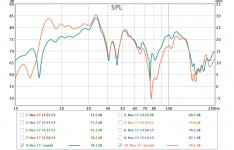 spl overlay.jpg96.2 KB · Views: 211
spl overlay.jpg96.2 KB · Views: 211 -
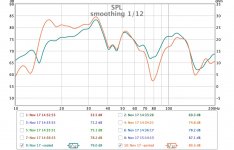 spl overlay smoothed .jpg93.3 KB · Views: 205
spl overlay smoothed .jpg93.3 KB · Views: 205 -
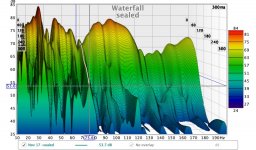 sealedwater.jpg163.7 KB · Views: 194
sealedwater.jpg163.7 KB · Views: 194 -
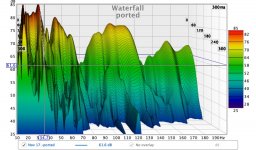 portedwater.jpg157.6 KB · Views: 179
portedwater.jpg157.6 KB · Views: 179 -
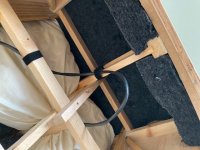 IMG_1009 - Copy.jpg99.8 KB · Views: 190
IMG_1009 - Copy.jpg99.8 KB · Views: 190 -
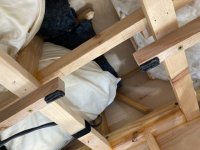 IMG_1012 - Copy.jpg88.8 KB · Views: 130
IMG_1012 - Copy.jpg88.8 KB · Views: 130 -
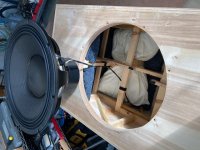 IMG_1011 - Copy.jpg107.9 KB · Views: 135
IMG_1011 - Copy.jpg107.9 KB · Views: 135 -
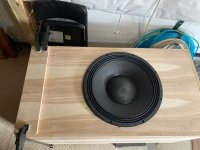 IMG_1013 - Copy.jpg93.1 KB · Views: 146
IMG_1013 - Copy.jpg93.1 KB · Views: 146
Last edited:
Nice to hear you have noticeable improvements!
Loss of spl is to be expected going from unlined ported to sealed. Have you hit the clip indicators on the amp yet? Probably time for a bigger amp if you have. If not, you might need another gain stage to drive the amp to full power.
These woofers aren't really meant to go much higher than 100hz. That being said, Josh Ricci of Data-Bass had no problems getting a clean 200hz out of all the 21's he's tested in a 24" sealed cube. You might have to divide the internals into smaller compartments by placing dividers along both planes if you want to go higher than 100hz. Or even more stuffing as long as you have free space directly around the driver(don't want the material to couple directly to cone movement).
Loss of spl is to be expected going from unlined ported to sealed. Have you hit the clip indicators on the amp yet? Probably time for a bigger amp if you have. If not, you might need another gain stage to drive the amp to full power.
These woofers aren't really meant to go much higher than 100hz. That being said, Josh Ricci of Data-Bass had no problems getting a clean 200hz out of all the 21's he's tested in a 24" sealed cube. You might have to divide the internals into smaller compartments by placing dividers along both planes if you want to go higher than 100hz. Or even more stuffing as long as you have free space directly around the driver(don't want the material to couple directly to cone movement).
Last edited:
I've never seen the amp clip, but I was playing tonight with my minidsp and I was able to apply a shelf to raise the output 9db before hitting the top of the display curve I was looking at, and that let me get a bit more volume out of it. Its acting like a line driver, but I dont know if there is a distortion tradeoff there.
My amp has an input setting switch for balanced vs rca. balanced says 2v, and the rca says 1v. I have it set to balanced as that is what I'm using, but I recall messing up one time and setting one channel to rca and it did give me noticeably more output. I need to look into whether thats ok to mess with. I have never seen my amp clip, or even get warm while using the sub.
What do you guys normally use as a line driver?
I've been listening to the sub more with music tonight.. Its significantly better, not just a little. I cant believe the difference in SQ (and lack of output) by adding the fill.
My amp has an input setting switch for balanced vs rca. balanced says 2v, and the rca says 1v. I have it set to balanced as that is what I'm using, but I recall messing up one time and setting one channel to rca and it did give me noticeably more output. I need to look into whether thats ok to mess with. I have never seen my amp clip, or even get warm while using the sub.
What do you guys normally use as a line driver?
I've been listening to the sub more with music tonight.. Its significantly better, not just a little. I cant believe the difference in SQ (and lack of output) by adding the fill.
I believe that amp has a .775v input sensitivity setting. This should get you closer to full power with your current equipment. Might even be able to hit clipping. If that doesn't work, pretty much any cheap little prosound mixer will get the job done.
The amp is in bridged mode on the dsp, are you using the binding post or speakon? Is it wired correctly?
This amp bridged into that box at clipping should bury your other subs in sheer output.
The amp is in bridged mode on the dsp, are you using the binding post or speakon? Is it wired correctly?
This amp bridged into that box at clipping should bury your other subs in sheer output.
Last edited:
- Home
- Loudspeakers
- Subwoofers
- Eminence NSW6021 21" sub users - which amp are you using?
